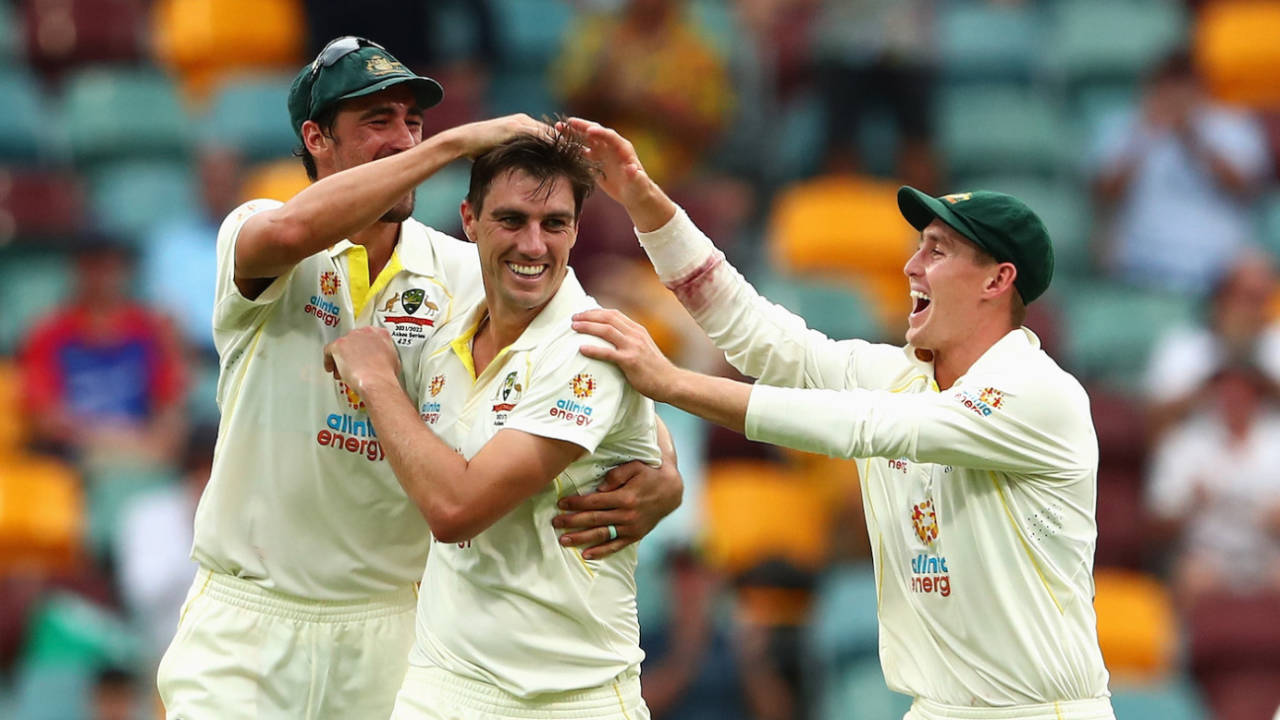The board is also looking at “optimising travel schedule” after mass resting during ODI series loss
Mitchell Starc, Marnus Labuschagne and Pat Cummins were among the five players rested from the final ODI • Getty Images
Cricket Australia’s CEO Nick Hockley has defended the selectors’ decision to rest Australia’s Test players from the series-deciding ODI loss to Pakistan in Perth, but has revealed that CA is looking closely at the travel schedule for next summer’s white-ball series against India prior to Ashes to try and ensure Australia can field its best XI more often.
CA and Australia’s selectors have faced some public criticism in the aftermath of Sunday’s ODI series loss when Pat Cummins, Josh Hazlewood, Mitchell Starc, Steven Smith and Marnus Labuschagne were all rested from the trip to Perth to freshen up before the first Test, despite an 11-day gap between the last ODI and the first Test, which is also in Perth, from November 22.
But it is understood it had been long-planned from when the schedule was announced that the fast bowlers in particular would rest from the final ODI ahead of the Test series with a massive summer including seven Tests across the Border-Gavaskar series and the Sri Lanka tour, followed by the Champions Trophy.
Australia’s strength and conditioning and medical staff have strong historical data that suggests that their fast bowlers are at huge risk of injury off a one-day break with a lengthy flight included, as was the case with the third ODI in Perth scheduled on Sunday, just two days after the second ODI in Adelaide. Australia experienced a very recent example of that issue in the UK when they lost six fast bowlers to injury, even without the issue of lengthy domestic flights included.
It is understood that even if the third ODI was in Sydney, it is unlikely the three quicks would have played all three matches in any case although the match that they rested may have changed.
“The amount of planning and work that goes into into squad selection and preparation across three formats, it is incredible in the detail they go to,” Hockley said at the MCG on Tuesday.
“Certainly, in terms of the Test players, we want to get them through what’s effectively seven Test matches, kind of back to back, and then for the all-format players into the Champions Trophy. It was felt on this occasion it was in the best interest of the overall priorities for the summer that they miss out on the third ODI.”
Hockley said the lessons of last week will be fresh in the mind when CA finalises the schedule for next summer’s white-ball series against India, which leads into the Ashes.
“I think we will have a look at that,” Hockley said. “I think what this schedule has really shone a spotlight on is that the travel schedule into such a big series is critical again. This is about thinking ahead and getting players through in the best possible condition. So, yeah, as we look to the schedule for next year, we’ll get right into the detail to make sure that the travel schedule is optimised so we can continue to put our best possible XI on the field.”
The major issue is that the commercial needs do not necessarily match those of the team. In an ideal world, Australia believe they could field their full-strength XI in all three games of a week-long ODI series if they were spaced out evenly with three-day gaps in between each game. But such a scenario would mean that the middle game of the series would fall on a Wednesday in early November while the work and school year were still in full swing in Australia, which is sub-optimal for broadcasters and venues to maximise viewers and crowd numbers. As a result, there is a preference for Friday and Sunday games on the same weekend with the teams travelling in between.
Pakistan played the same XI in all three games, with their four quicks backing up a superb performance in Adelaide with an even better display in Perth. But none of the four played in the last two Tests against England before the tour to Australia, and Shaheen Shah Afridi and Naseem Shah will both be rested from Pakistan’s upcoming tour of Zimbabwe, which follows this week’s T20I series, to further illustrate the difficulties all countries have of fielding full strength XIs for every international game.
“We often have been criticised in the past for not giving new players an opportunity to come in,” Hockley said. “There was a plan in place, and that plan was really to make sure that our all-format players were in absolutely peak condition for the upcoming Border-Gavaskar series.
“This was obviously a massively disappointing result, but I think a really good opportunity to expose some of the talent that’s coming through to the pressures of international cricket. And on this occasion, I think they were they were found wanting by a very competitive and spirited Pakistan.”
Alex Malcolm is an associate editor at ESPNcricinfo



